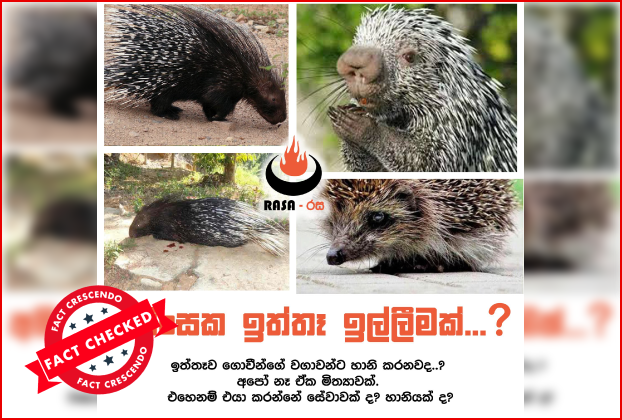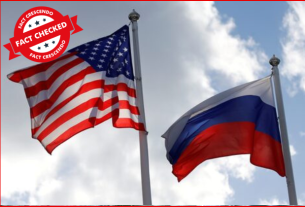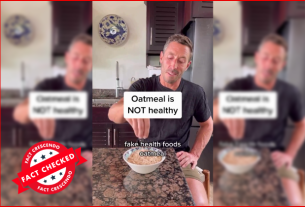Human-wildlife conflict is not a new thing in a country like Sri Lanka. In the Sri Lankan Human-wildlife context, elephants are the most discussed animal within non-agricultural communities. But apart from the elephants, many other animals have conflicts with humans.
Porcupines are one of the animals discussed as crop-harming animals within agricultural communities.
Social Media Posts
A post claiming that porcupines are not animals harming the crops was shared among Facebook users.

Many engaged with these posts with both positive and negative comments.

Fact Check
With the keyword search, we found this claim was making rounds for a few years, as seen by this post from 2022. Archived.
In the original post, the names of the animals described were not mentioned. The only way to understand the described animal is through the photos attached to the post. In the original post, the animal displayed in the image is not a porcupine. It is a hedgehog. With further investigations, we found that the animal in the AfghanHemiechinus auratus megalotis.

According to the records, there are no hedgehogs in Sri Lanka. However, some species of hedgehogs can be found in several other Asian countries. Long-eared hedgehogs are native to Central Asian countries, and some can be found in some countries in the Middle East as well.
As the original post mentioned, hedgehogs are introduced as gardener’s friends. They do not care much about eating plants or seeds. They like to eat beetles, caterpillars, slugs, and many other crops that harm insects. Here for more about that.
As the post says, hedgehogs are lactose intolerant. So, it is not healthy for hedgehogs to drink milk. Here are hedgehogs’ feeding patterns.
But in the Sri Lankan post, the displayed pictures do not belong to hedgehogs. Those are porcupines, and a caption in those photos says, “Innocent Request from Porcupines.”
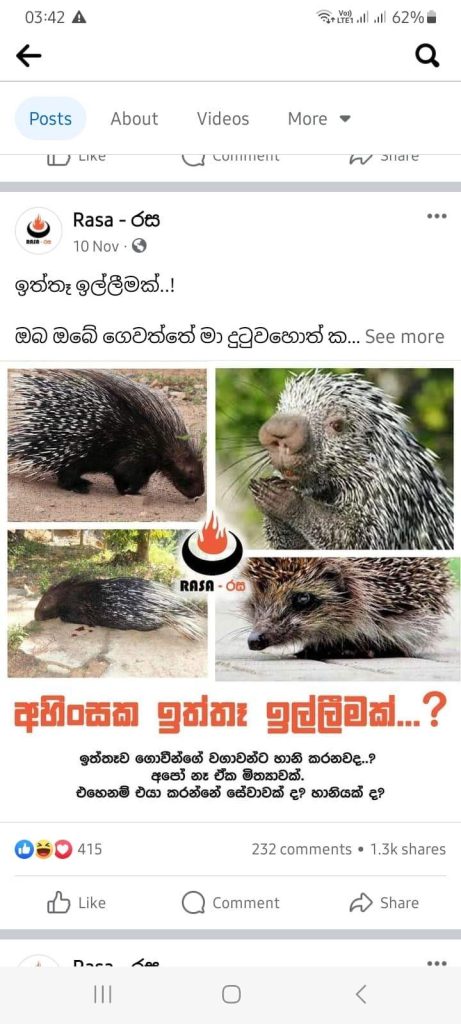
Porcupines can commonly be found in Sri Lanka, even in urban areas. Indian crested porcupine (Hystrix indica) is the main species which can be found in Sri Lanka.
Differences between Porcupines and Hedgehogs
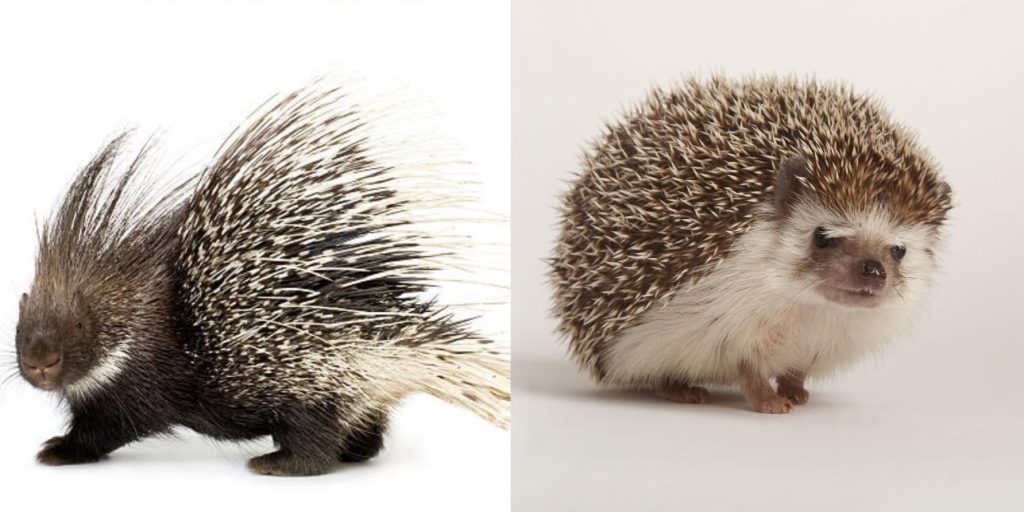
Both the porcupine and hedgehog are mammals, but they are hardly related at all in classification. Two of them belong to two different orders. While porcupine belongs to Order Rodentia along with rats and mice, hedgehog belongs to Order Erinaceidae.
Both porcupines’ and hedgehogs’ diets are mainly considered omnivorous. But their eating habits and preferences are not the same. Porcupines are majorly eating plant parts and woody plants more than insects. They rarely eat small animals. So, in some cases, they are considered herbivores.
But hedgehogs mainly depend on small insects and sometimes other small animals such as millipedes, caterpillars, slugs, snails, etc. Sometimes, they are introduced as insectivores. But rarely do they eat berries and other plant materials. While porcupines eat herbs as their primary diet, hedgehogs’ diet mainly comprises insects.
Porcupines are much larger in size compared to that of hedgehogs. Adult porcupines can increase their length up to 36 inches. But an adult hedgehog’s maximum length will be only 12 inches. Weight is also higher in porcupines.
Quills of hedgehogs are smaller and shorter than porcupine quills. While porcupine has up to 30000 quills, hedgehog only has 3000 to 5000 quills.
Here is an article about the differences between porcupines and hedgehogs.
Indian Crested Porcupine – Hystrix indica:
Indian crested porcupine can be found in many South, Southeast and Central Asian countries. The average size of an Indian crested porcupine is around 70 – 90 centimeters in length. Its hair is modified into spines that have covered the upper part of its body. These spines are called quills; each is brown or black with alternating bands of white.

Indian crested porcupines are omnivores. But they prefer to eat agricultural plant materials more, including roots, bulbs, fruits, grains, drupes and tubers. Sometimes, they eat small insects and small vertebrates.

Crop Damage by Indian Crested Porcupine:
Indian crested porcupine is the most significant rodent pest that damages many crops, vegetables, and other plants in Asian countries. Some research in Asia that was conducted with the data of local farmers says that they see porcupines as one of the main pests for their crops. Here is some data on that from Pakistan.
As mentioned above, though porcupines are omnivores, their main meal consists of herbs. Indian crested porcupines prefer to eat a wide range of crops, including maize, sweet potatoes, groundnut, banana, coconut, pumpkin, cane, paddy, acacia, and many others. This directly harms the crop quantity and quality of the farmer.
Corn is considered to be the favourite food item of porcupines. Therefore, corn crops are highly impacted by porcupines. Here is a research article on their harm to crops.
In India, there are records of porcupines harming saffron fields by damaging lands for growing saffron. Here for more on that. Indian crested porcupines love to have a woody diet as well. They chew on the tree bark in their exhibit several days a week. They gnaw the branches, twigs and barks of woody trees. Girdling of the tree bark like this can even kill the plant if the damage is severe.
While the porcupines are foraging for food throughout the agricultural fields, they can be harmed by their foraging patterns. Here is a research article on crop damage by porcupines in Jammu Kashmir.
Accordingly, we can have an idea that Indian crested porcupines are a type of agricultural pest in Asian countries of many kinds of fields.
Are Indian Crested Porcupine Helpful for Farmers:
As Indian crested porcupines are omnivores, they eat small insects and other small vertebrates as their diet. But their high preference is for herbs and other plant parts. So, there is less possibility for porcupines to forage for insects and eat them in a field full of greens.
When they are trying to forage for small animals to eat, they try to dig and scratch the soil near tree roots and by this, tree roots are harmed, and sometimes, they may damage the tree. So, the harm that porcupines cause is more significant than their help to farmers.
Are They Lactose Intolerance:
According to current data, unlike hedgehogs, there is no record to prove that porcupines are lactose intolerant.
Conservation Status of Indian Crested Porcupines:
Throughout their range, Indian crested porcupines are common. They can commonly be found even in urban areas. But they do not forage in daylight; they just come out at night. So, it is not easy to see them in the daytime. But at night, they can even be found by the sides of roads. Indian crested porcupines can adapt to their habitat well since they have a comprehensive environmental and geographical range and a wide range of diets.
According to the IUCN Red List, Indian crested porcupines are categorised as ‘Least Concern.’
Are Porcupines Important?
Porcupines play a role in the ecosystem by helping control plant growth through their feeding habitats. Their foraging helps maintain a balanced vegetation. Additionally, they contribute to nutrient cycling as their scat enriches the soil.
Misconception on Porcupine Quills
Can Porcupine shoot their Quills:
The quills are a porcupine’s defensive mechanism. There is a claim among people that porcupines shoot their quills towards their enemies for defence. But this is a widespread misconception. They cannot shoot their quills like arrows. When porcupines feel threatened, they arch their back and raise the spines on their tails. With this, the barbed quills pointed outward in every direction. With even the slightest touch or attack of the predator in this time, the quills easily detach, and the predator will be attacked. Here, to read more about their defensive methods. Here and here are the videos on porcupine defense from a predator.
Are Porcupine Quills Poisonous or Venomous:
There is another claim about porcupine quills that they are poisonous. But that is also a misconception. If someone is injured with them, it is excruciating. But it is not because of poison. The quill tip gets lodged into the skin, making removing them difficult and painful. But it should be removed carefully without increasing the damage to the skin. Also, this can cause infections as well.
Porcupines do not commonly attack humans, but cats and dogs are widely assaulted with them. Here for more on this.

Threats to Porcupines
Though the porcupine is a common animal, many threats have challenged them. One of the main threats is the threat of being hunted. Despite their spiky exterior, there are many predators for porcupines, such as leopards, pythons, and wolves. But more than all of these natural predators, the worst enemy of porcupines is humans. Humans in many countries hunt porcupines for different reasons.
The central aspect of hunting porcupines is obtaining their meat for food. Porcupine meat is very nutritious, so some people prefer to eat it. Also, porcupines are considered a nuisance due to their impact on crops, leading to hunting as a form of pest control.
In the 1900s, landowners and foresters in Western countries killed porcupines as they chewed plywood off human houses.
In Southeast Asia, porcupines are hunting for their medicinal value. The bezoar stones of porcupines are a valuable traditional medicine in those countries. Porcupine bezoar is a mass of chewed, calcified, undigested material which can generally be found in porcupines’ gastrointestinal tracts. However, the main targeted species for porcupine bezoar is Hystrix brachyura.

In some regions, porcupines are hunted for their quills. These quills are utilised. For example, they serve as musical instruments and were once used as containers for gold dust.

Urbanisation and destruction of their habitat also cause trouble for porcupines. With these things, they were killed by hunters as well as died in vehicle collisions in urban areas.
Porcupines have a low reproductive rate and long gestation rate, unlike other rodents. This makes them more vulnerable to human threats.
Anyway, in most countries, killing and hunting porcupines is illegal. But still, the hunting of porcupines continues in many countries worldwide.
Threats to Porcupines in Sri Lanka:
In Sri Lanka, porcupines face threats like habitat destruction due to deforestation and human expansion. Additionally, they may be at risk from road accidents. Even in urban areas like Colombo, porcupines can be found on the sides of roads or sometimes in the middle of the street’s early morning or night.
Also, the illegal hunting of porcupines for meat consumption is widespread in Sri Lanka. Especially in reservoir areas, illegal hunters prepare different kinds of traps to capture porcupines and kill them for meat.
Unfortunately, in Sri Lanka, Indian crested porcupines are no longer protected from 2022. Permission to cull them has been granted as they act as pests for the crops. The crop damage from a few wild animals, including porcupines, was more significant, and this step was announced as the solution for reducing that crop damage. Here is the news article.
Anyway, porcupines in Sri Lanka are more dangerous as culling them is no longer illegal. So, finding another method to control their population without letting humans cull these animals is essential.
How Does Climate Change Affect Porcupines?
Climate change can impact porcupines and their habitats in several ways. Shifts in temperature and precipitation patterns may alter the availability of food sources, affecting the porcupines’ diet and overall nutrition. Changes in vegetation and habitat structure can also influence their ability to find suitable shelter and forage food.
With habitat loss, porcupines have moved into more urbanised areas, exposing them to the human population. This is the reason for them to be more exposed to vehicle collisions. Also, without a perfect habitat to live in the daytime, they are easily targeted by hunters. Some hunters trap them in their pits. A pit in a well-covered habitat may lead porcupines to more danger.
Furthermore, climate change may impact the distribution of predators and competitors, affecting the overall ecosystem dynamics that porcupines are part of. Adapting to these changes can be challenging for porcupines, and their populations may face increased stress and vulnerability. Conservation efforts are crucial to mitigate these effects and support the resilience of the porcupine population in a changing climate.
Follow us and stay up to date with our latest fact checks.
Facebook | Twitter | Instagram | Google News | TikTok
Conclusion:
The claim in the Sinhala post saying that the porcupines are not damaging any crops is misleading. The Sinhala post is a translation from posts about hedgehogs. Hedgehogs don’t much care for eating plants, they much prefer beetles, caterpillars, slugs and snails hence are considered to be generally friendly for your garden.
However, the same cannot be said about porcupines. Though porcupines and hedgehogs are similar in appearance (especially with the quills), they are not the same species or very much related. Porcupines tend to damage young coconut plants and vegetables, so it’s not a myth that they harm certain types of crops about hedgehogs does not apply to porcupines.

Title:Do Porcupines Harm Agricultural Crops?
Fact Check By: Fact Crescendo TeamResult: Missing Context



